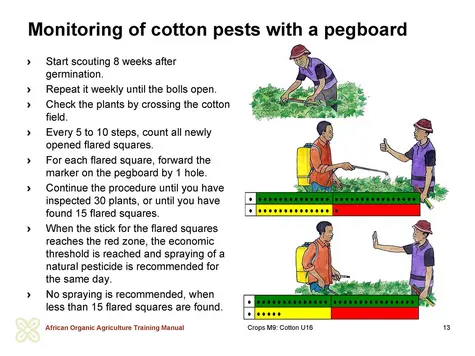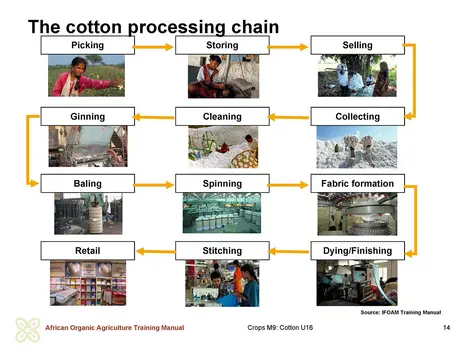Improving postharvest handling
The price of cotton depends on its quality. The cleaner and the longer the fibres are, the higher their price. Markets prefer clean, white fibres with long staple length, good strength, non-stickiness, low amounts of short fibres, and fine, rather than coarse lint. Therefore, cotton handling should be given sufficient attention at all stages.
Picking, grading and storage
Cotton picking should be done with care, avoiding leaves and damaged or immature cotton. Grading of cotton can easily be done with the help of a second, smaller picking bag for the inferior quality. In order to fetch a better price, only ripe cotton should be picked.
If farmers store the harvested cotton before selling it, they must avoid any contamination through dust or chemicals. The storage place must be clean and dry. Damp conditions can lead to moulds with significant loss of cotton quality. Where the organic harvest is stored in the same facilities together with conventional cotton (for example in ginneries), mixing of organic and non-organic produce must be avoided. Appropriate storage conditions contribute to about a fourth to maintaining cotton quality. Storage should be done off the ground and protected from rain or standing water. To avoid mixing, the store personnel must be instructed accordingly, incoming and dispatched organic lots must be documented and different cotton qualities should be marked with sign boards, for example using colour codes.
Processing
Throughout the entire organic cotton processing chain, contamination with GMO cotton and synthetic residues must be avoided. Therefore, organic cotton needs to be treated separately from conventional cotton. Where spinning mills and processing entities process organic and conventional cotton on the same machinery, clear separation and cleaning of the equipment is necessary before processing an organic lot. Some labels and brands also have certain restrictions on which dyes can be used.
Discussion on postharvest handling of cotton
Ask the farmers to describe common handling of cotton after harvest, as it is practiced in the area. Together, identify gaps and discuss appropriate improvements.


 tap and then scroll down to the Add to Home Screen command.
tap and then scroll down to the Add to Home Screen command.